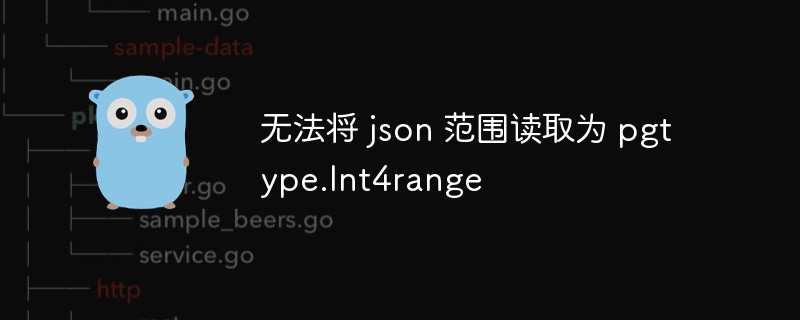Unable to read json range into pgtype.Int4range

php editor Baicao may encounter an error message when using PHP and PostgreSQL database: "Unable to read json range as pgtype.Int4range". This error usually occurs when trying to convert the JSON data type to the pgtype.Int4range data type. The solution to this problem is not complicated. You only need to convert the JSON data to a string and then perform data type conversion. Next, we will detail how to solve this problem.
Question content
I'm trying to read a range into json but I'm having trouble doing json.unmarshal.
This is a test code-
import (
"encoding/json"
"testing"
"github.com/jackc/pgtype"
"github.com/stretchr/testify/assert"
)
type testhealthpreference struct {
healthrange pgtype.int4range `json:"health_range"`
id string `json:"id"`
}
// just a test to make sure unmarshaling works
func testpreferenceupdateunmarshal(t *testing.t) {
jsondata := `{
"health_range": "[20,30)",
"id": "123"
}`
var update testhealthpreference
err := json.unmarshal([]byte(jsondata), &update)
if err != nil {
t.errorf("error while unmarshalling json: %v", err)
}
assert.equal(t, 20, update.healthrange.lower)
}mistake-
Error while unmarshalling JSON: json: cannot unmarshal string into Go struct field TestPreference.health_range of type pgtype.Int4range.
Is it possible to read it as pgtype.int4range? I guess this type is for database use only? fwiw, I'm using pgx github.com/jackc/pgx/v4
Workaround
It doesn't work because "[20,30)" is not a struct A valid json value for pgtype.int4range, and pgtype.int4range does not yet implement the json.unmarshaler interface.
You must implement the interface to unmarshal yourself "[20,30)":
type myint4range pgtype.int4range
func (r *myint4range) unmarshaljson(b []byte) error {
return (*pgtype.int4range)(r).decodetext(nil, bytes.trim(b, `"`))
}
by the way
assert.equal(t, 20, update.healthrange.lower)
Comparing two different types, should be corrected to:
assert.Equal(t, int32(20), update.HealthRange.Lower.Int)
View the full demo here: https://www.php.cn/link/fbf6e9ffad68f73e466198206987dedc一个>.
The above is the detailed content of Unable to read json range into pgtype.Int4range. For more information, please follow other related articles on the PHP Chinese website!

Hot AI Tools

Undresser.AI Undress
AI-powered app for creating realistic nude photos

AI Clothes Remover
Online AI tool for removing clothes from photos.

Undress AI Tool
Undress images for free

Clothoff.io
AI clothes remover

Video Face Swap
Swap faces in any video effortlessly with our completely free AI face swap tool!

Hot Article

Hot Tools

Notepad++7.3.1
Easy-to-use and free code editor

SublimeText3 Chinese version
Chinese version, very easy to use

Zend Studio 13.0.1
Powerful PHP integrated development environment

Dreamweaver CS6
Visual web development tools

SublimeText3 Mac version
God-level code editing software (SublimeText3)

Hot Topics
 1655
1655
 14
14
 1413
1413
 52
52
 1306
1306
 25
25
 1252
1252
 29
29
 1226
1226
 24
24
 Golang's Purpose: Building Efficient and Scalable Systems
Apr 09, 2025 pm 05:17 PM
Golang's Purpose: Building Efficient and Scalable Systems
Apr 09, 2025 pm 05:17 PM
Go language performs well in building efficient and scalable systems. Its advantages include: 1. High performance: compiled into machine code, fast running speed; 2. Concurrent programming: simplify multitasking through goroutines and channels; 3. Simplicity: concise syntax, reducing learning and maintenance costs; 4. Cross-platform: supports cross-platform compilation, easy deployment.
 Golang and C : Concurrency vs. Raw Speed
Apr 21, 2025 am 12:16 AM
Golang and C : Concurrency vs. Raw Speed
Apr 21, 2025 am 12:16 AM
Golang is better than C in concurrency, while C is better than Golang in raw speed. 1) Golang achieves efficient concurrency through goroutine and channel, which is suitable for handling a large number of concurrent tasks. 2)C Through compiler optimization and standard library, it provides high performance close to hardware, suitable for applications that require extreme optimization.
 Golang vs. Python: Key Differences and Similarities
Apr 17, 2025 am 12:15 AM
Golang vs. Python: Key Differences and Similarities
Apr 17, 2025 am 12:15 AM
Golang and Python each have their own advantages: Golang is suitable for high performance and concurrent programming, while Python is suitable for data science and web development. Golang is known for its concurrency model and efficient performance, while Python is known for its concise syntax and rich library ecosystem.
 Golang vs. Python: Performance and Scalability
Apr 19, 2025 am 12:18 AM
Golang vs. Python: Performance and Scalability
Apr 19, 2025 am 12:18 AM
Golang is better than Python in terms of performance and scalability. 1) Golang's compilation-type characteristics and efficient concurrency model make it perform well in high concurrency scenarios. 2) Python, as an interpreted language, executes slowly, but can optimize performance through tools such as Cython.
 The Performance Race: Golang vs. C
Apr 16, 2025 am 12:07 AM
The Performance Race: Golang vs. C
Apr 16, 2025 am 12:07 AM
Golang and C each have their own advantages in performance competitions: 1) Golang is suitable for high concurrency and rapid development, and 2) C provides higher performance and fine-grained control. The selection should be based on project requirements and team technology stack.
 Golang's Impact: Speed, Efficiency, and Simplicity
Apr 14, 2025 am 12:11 AM
Golang's Impact: Speed, Efficiency, and Simplicity
Apr 14, 2025 am 12:11 AM
Goimpactsdevelopmentpositivelythroughspeed,efficiency,andsimplicity.1)Speed:Gocompilesquicklyandrunsefficiently,idealforlargeprojects.2)Efficiency:Itscomprehensivestandardlibraryreducesexternaldependencies,enhancingdevelopmentefficiency.3)Simplicity:
 Golang and C : The Trade-offs in Performance
Apr 17, 2025 am 12:18 AM
Golang and C : The Trade-offs in Performance
Apr 17, 2025 am 12:18 AM
The performance differences between Golang and C are mainly reflected in memory management, compilation optimization and runtime efficiency. 1) Golang's garbage collection mechanism is convenient but may affect performance, 2) C's manual memory management and compiler optimization are more efficient in recursive computing.
 C and Golang: When Performance is Crucial
Apr 13, 2025 am 12:11 AM
C and Golang: When Performance is Crucial
Apr 13, 2025 am 12:11 AM
C is more suitable for scenarios where direct control of hardware resources and high performance optimization is required, while Golang is more suitable for scenarios where rapid development and high concurrency processing are required. 1.C's advantage lies in its close to hardware characteristics and high optimization capabilities, which are suitable for high-performance needs such as game development. 2.Golang's advantage lies in its concise syntax and natural concurrency support, which is suitable for high concurrency service development.




